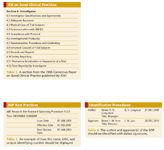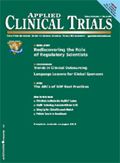SOPs: A Must for Sites
Detailed instructions for creating strong SOPs that can serve as the backbone of studies and sites.
Standard Operating Procedures (SOPs) are detailed, written instructions that specifically describe how to complete research-related activities; they are statements of who does what, where, when, why, and how. SOPs serve to document what has been agreed and adopted as standard practice. Well-written and well-managed SOPs provide an official and standard way to consistently execute required research-related activities. In addition, they can improve communication among staff, reduce dependence on individuals with institutional knowledge, and improve efficiency of staff training.

Anywhere and everywhere around our world, the independent clinical research site that maintains and operates under SOPs demonstrates it has a commitment to research and that consistent processes for research activities are present. To sponsors of worldwide trials, who view SOPs as necessary administrative support, your strong SOPs may be the favorable attribute that gets you through the site selection process successfully.
What to include?
SOPs are intended to support compliance with laws and regulations that govern the conduct of clinical research. It is not necessary to document every service you provide. What does makes sense, though, is for clinical research sites to establish standards for those responsibilities that regulatory authorities have attributed to the investigator—responsibilities that are subject to inspection. SOPs that establish standard practice for how you will meet these responsibilities will help you demonstrate to study monitors, auditors and/or inspectors that your responsibilities have been fulfilled. Consider starting with the stated responsibilities of the investigator found in The International Conference on Harmonisation (ICH) 1995 Consensus Paper for Good Clinical Practice. Remember, you may have additional responsibilities under local laws or regulations (Table 1 provides an example).

GCP for Research in India
How to begin?
The central feature of any SOP is a list of the steps or activities that constitute the required task. Begin by creating a flowchart of the selected process—identify the individual steps (what to do) and place them in logical order. Once the process is mapped, you may want to consider improvements to simplify it, eliminate unnecessary, fragmented or duplicated effort, or open bottlenecks. Then, turn the flowchart into a narrative that assigns process steps to roles (who will do it) and includes details as necessary (how to do it). Each procedure should be clearly and concisely written with little room for interpretation. Use functional role descriptions rather than titles or names that are subject to frequent change. Allow for flexibility where appropriate. Ensure that your procedure is compliant with the laws and regulations that you seek to support.

As an example, consider ICH Good Clinical Practice 4.2.4. This section states, 'The investigator should ensure that all persons assisting with the trial are adequately informed about the protocol, the investigational product(s), and their trial-related duties and functions." A well-written, well-managed SOP on clinical staff roles and responsibilities can help an investigator demonstrate that conditions of section 4.2.4 are met. The SOP identifies the roles and responsibilities of individuals participating in conduct of research trials at this site, how and where trial-specific delegated duties are logged, and how and when staff is trained in protocol/product-specific content. Addendums to this SOP could include job descriptions, a trial-specific task delegation log, and a protocol/product-specific training log.
Necessary features
Each SOP should have a prominently displayed descriptive name/title and a unique identifying number on its first page. It is best practice to use an informative numbering format that places each SOP in the context of other titled SOPs and in the context of other versions of same-titled SOPs. For example, a research site has 10 titled SOPs. The SOP on Informed Consent is the fifth in the series. The first approved and issued version is numbered 5.1.0. After one year, it is reviewed. During the review process, drafts are successively labeled 5.1.1, 5.1.2, and 5.1.3. The final approved and issued revision is numbered 5.2.0.
The SOP author and approver(s) should be identified with dated signatures—these are the individuals responsible for the completeness and accuracy of the SOP.
An Issue Date on the first page indicates the date the SOP is distributed. An Effective Date should appear as well—this is the date the SOP becomes operative and should allow adequate time for training. The anticipated Next Review Date should appear on the first page. After a review, the version number will advance (the advanced number confirms the review has taken place even if no revisions have been made) and a new anticipated Next Review Date will be shown. In addition, subsequent versions should include a statement that this version replaces an earlier version from an earlier date. Note that all dates within the SOP series should be described using a single format such as DD/MMM/YYYY.
Associated forms, templates, flowcharts, and/or references should become appendices to the SOP, and should be dated, titled, and approved along with the procedure. Each SOP should include a distribution list to record that it was distributed to all involved in the work described and to indicate the location of the official original SOP document. An SOP must be understood by its users and should be written in the local language. If necessary, an authorized translation should be made available to external customers who may not understand the language (sponsors, regulatory inspectors).
Each set of SOPs should include an "SOP on SOPs." This is a standard procedure describing the preparation, layout, approval, control, maintenance, and implementation (including training) of SOPs.
Training and implementation
SOPs should be issued prior to their effective dates to allow sufficient time for training before they become effective. Training may be as simple as reading and understanding the SOP. Alternatively, training may take the form of group instruction/discussion, one-to-one instruction, e-module instruction or other. Regardless of the format, training should be properly documented and documentation should be maintained and available for inspection. Remember to train and document training of new staff and temporary staff on SOPs pertaining to their work activities before they begin to perform the described activities. Also, remember that training is required for newly issued revised SOPs, as well, and staff should be trained prior to the effective date for implementation.
Maintenance of SOPs
It is best practice to integrate SOPs into a comprehensive document management system. Original SOP documents are maintained in a secure location. Expired original SOPs are annotated as "Archived" and maintained so they can be retrieved for reference or for inspection. To eliminate confusion, photocopies of expired SOPs are destroyed once a new version is effective.
SOPs must be regularly reviewed and updated because regulatory requirements change and because our ways of working evolve and improve over time.
A deviation from the SOP occurs when research-related activities do not comply with the written procedure and when the protocol has not mandated and described this change. Deviations are to be documented and authorized. It is not acceptable to continuously deviate from a standard operating procedure; this means that the standard procedure is not standard and needs revision.
References
1. Good Clinical Practices for Clinical Research in India, http://cdsco.nic.in/html/GCP.htm.
Sheila Ronkin, MD, MBA, is Assistant Vice President, Clinical Development, for Wyeth Research, 500 Arcola Road B4206A, Collegeville, PA 19426, email: ronkins@wyeth.com.

Improving Relationships and Diversifying the Site Selection Process
April 17th 2025In this episode of the Applied Clinical Trials Podcast, Liz Beatty, co-founder and chief strategy officer, Inato, discusses a number of topics around site engagement including community-based sites, the role of technology in improving site/sponsor relationships, how increased operational costs are impacting the industry, and more.
SCOPE Summit 2025: Enhancing the Patient Experience Through Site Centricity
February 12th 2025In an interview with ACT senior editor Andy Studna at SCOPE Summit, Ashley Davidson, vice president, product lead - sponsor tech strategy, Advarra, highlights the need for more site-centric approaches in study startup.